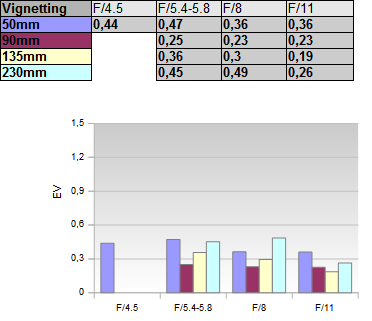|
Fujinon XC 50-230mm f/4.5-6.7 OIS - Review / Lens Test Report - Analysis |
|
Lens Reviews -
Fujifilm X
|
|
Page 2 of 2

Distortion
Fujifilm relies on image auto-correction so users don't really need to worry about image distortions.
That being said it is always interesting to have a look behind the scenes. The uncorrected RAW files show medium to high pincushion distortions from 90mm onward which is somewhat worse than in corresponding DSLR lenses. The 50mm doesn't show any relevant distortions even in RAW mode.
If you move your mouse cursor over the image you can switch to the corresponding auto-corrected results (there may be a short delay).
Vignetting
Vignetting is another aspect that is usually auto-corrected. While you may still spot a few remaining traces, a max. light falloff of 0.5EV (f-stop) isn't anything to worry about using conventional image processing.
 In RAW mode - thus with disabled distortion and vignetting compensation - things aren't quite as shiny. The light falloff is rather massive in excess of 1.6EV at the extreme ends. Stopping down eases the vignetting but you have to choose f/8 in the low to mid range and f/11 at 230mm to control the issue.
In RAW mode - thus with disabled distortion and vignetting compensation - things aren't quite as shiny. The light falloff is rather massive in excess of 1.6EV at the extreme ends. Stopping down eases the vignetting but you have to choose f/8 in the low to mid range and f/11 at 230mm to control the issue.
 Please note that vignetting compensation is also a lossy procedure because it increases the corner (sensor-)noise.
Please note that vignetting compensation is also a lossy procedure because it increases the corner (sensor-)noise.
MTF (resolution)
The Fujinon XC 50-230mm f/4.5-6.7 OIS cannot touch the XF 55-200mm f/3.5-4.8 R LM OIS in terms of resolution but the results are quite Ok for a kit zoom lens. Unsurprisingly the sweet spot is at 50mm. The center quality is very good to excellent in the relevant aperture range. The borders/corners follow on a good to very good level. There's a slightly increasing quality penalty the more you zoom out. However, generally the center remains very good and the outer image region is still good. Diffraction has a higher impact from f/11 onward. The lens exhibits only a very slight degree of field curvature.
The centering quality of the tested sample was Ok.
Please note that the MTF results are not directly comparable across the different systems!
Below is a simplified summary of the formal findings. The chart shows line widths
per picture height (LW/PH) which can be taken as a measure for sharpness.
If you want to know more about the MTF50 figures you may check out the corresponding
Imatest Explanations
Chromatic Aberrations (CAs)
Lateral CA (color shadows at the image borders) are well controlled between 50mm and 90mm. However, and that's a bit unusual, there's a local peak around 135mm with an average CA pixel width of 2px at the image borders and max. aperture. This improves when stopping down though. Surprisingly the CAs ease again towards the 230mm setting with a pixel width of around 1.1px here.

Bokeh
Due to the slow speed of the lens we didn't conduct a full analysis of the bokeh (quality of the out-of-focus blur). However, we had a look at the highlight rendition. Highlight discs are quite evenly rendered combined with a moderate outlining effect. A more edgy aperture shape is visible from f/11 onward. The highlight discs are deteriorating towards the borders. This happened fairly "early" thus from midfield onward. These "cat's eyes" are a vignetting effect and, as mentioned earlier, this is a weakness of the Fujinon.

VerdictThe Fujinon XC 50-230mm f/4.5-6-7 OIS is a good performer in relation to its price level. The results are mostly sharp in the image center. The corners aren't quite as snappy in the upper range but let's be fair - you don't tend to place the main subject of your scene into the extreme corners anyway. The level of CAs is pretty good at the extreme ends with a weak spot (135mm) in between. Distortions and vignetting are taken care of by the automatic image correction. However, the original characteristics are quite a bit worse though - especially in terms of light falloff.
As far as build quality is concerned, you shouldn't expect wonders. The lens body is completely made of plastics and the build tolerances aren't quite as tight as on the Fujinon XF lenses. The comparatively low price tag takes its toll here. That being said - the zoom action is a bit smoother than on the XF 50-200mm f/3.5-4.8 R LM OIS. The AF performs is pretty fast in bright conditions but slows down in low light - this is more an issue on the camera side though. The OIS (optical image stabilizer) works nicely but due the slow max. aperture of the lens this feature is also often needed.
Compared to the XF 50-200mm f/3.5-4.8 R LM OIS, we would place our bets on the XF. However, if your bank account manager starts crying, the XC 50-230mm f/4.5-6-7 OIS will be a viable choice without sacrificing too much quality.
Mechanical Quality:
★★★★★
Click here for an explanation of our star ratings
|